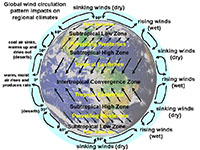9.1: The Atmosphere and Ocean Circulation Systems Are Linked
- Page ID
- 10280
The Atmosphere and Ocean Circulation Systems Are Linked
The global atmospheric circulation system influences the movement of air masses in general "belts" that move air in rotating masses within zones around the planet (Figure 9.1). These relatively stationary wind belts impact the surface of the oceans, creating currents that circulate waters in the oceans under the influence of Coriolis effect, creating five large subtropical gyres encircling the major oceans basins (Figure 9.2).
Currents in the oceans include surface currents and deep currents:
• surface currents are driven horizontally by effects of the wind.
• deep currents are driven horizontally and vertically by differences in density
(density changes typically start near the surface).
Ocean circulation is also influenced by seawater temperature and density.
• Warm water in the tropics flows in currents to polar regions where it cools and the formation of sea ice concentrates the salt in seawater, increasing its density so that it sinks.
• Cold and salty water (concentrated by surface evaporation) sinks. Elsewhere seawater rises where it is displaced by colder and saltier water.

Figure 9.1. Global wind circulation patterns impact regional climates and drive the large surface currents in the global ocean circulation system.

Figure 9.2. Five large gyres circulate surface waters in the global oceans. These rotating subtropical gyres are influenced by the patterns of atmospheric winds and the Coriolis effect.


